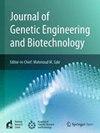尼日利亚山蜜的抗菌、抗氧化和抗癌活性与其菌群的关系
IF 2.8
Q3 Biochemistry, Genetics and Molecular Biology
Journal of Genetic Engineering and Biotechnology
Pub Date : 2025-08-25
DOI:10.1016/j.jgeb.2025.100559
引用次数: 0
摘要
许多研究调查了蜂蜜的生物活性,强调其抗菌、抗氧化和治疗特性。然而,对从蜂蜜中分离出来的细菌的全面检查在很大程度上被忽视了。这项研究旨在通过探索蜂蜜的生物活性和它所含的细菌孢子之间的关系来弥合这一差距。此外,也没有比较蜂蜜中的多糖,如levan和其固有的细菌。因此,各种酶,包括左旋蔗糖酶,转化酶,葡萄糖氧化酶,淀粉酶和过氧化氢酶,评估了尼日利亚山蜂蜜及其固有的7种细菌分离物。蜂蜜及其分离物均能产生不同程度的左旋蔗糖酶,其中分离物NO.4和蜂蜜的活性最高(21U/ml)。此外,蜂蜜及其分离物对淀粉酶和葡萄糖氧化酶的活性分别在171 ~ 465 U/ml、88 ~ 250 U/ml之间。定性试验结果显示,4号分离物过氧化氢酶活性最高。有趣的是,所有分离株都缺乏蛋白酶活性。蜂蜜和特定的分离物抑制多种致病菌,包括伤寒沙门氏菌、大肠杆菌和蜡样芽孢杆菌。此外,真菌,如白色念珠菌。此外,蜂蜜及其分离物的抗氧化活性在58% ~ 77%之间。多糖Lev1、Lev2和蜂蜜对正常细胞无细胞毒作用。经FTIR和NMR鉴定为levans。蜂蜜和level1、level2对HCT116细胞株的细胞毒性分别为61.5%、59.5%和53.70%。有趣的是,研究发现细菌的生物活性和蜂蜜本身有很强的联系。本文章由计算机程序翻译,如有差异,请以英文原文为准。
Potential antibacterial, antioxidant and anticancer activities of Nigerian mountain honey in relation to its bacterial flora
Numerous studies have investigated the biological activities of honey, emphasizing its antimicrobial, antioxidant, and therapeutic properties. However, a comprehensive examination of the bacteria isolated from honey has been largely overlooked. This study aimed to bridge that gap by exploring the relationship between the bioactivities of honey and the bacterial spores it contains. Furthermore, there is no comparison between the polysaccharides in honey such as levan and its inherent bacteria. Accordingly, various enzymes, including levansucrase, invertase, glucose oxidase, amylase, and catalase, were assessed in Nigerian mountain honey and their inherent seven bacterial isolates. Honey and its isolates showed levansucrase production to various degrees where the highest activity was obtained with isolate NO.4 and the honey recorded (21U/ml). Additionally, honey and its isolates showed varied activities between (171–465 U/ml), (88–250 U/ml) for amylase and glucose oxidase respectively. The highest catalase activity was recorded by isolate No 4 based on the qualitative test. Interestingly, all isolates lacked protease activity. Honey and specific isolates inhibited various pathogenic bacteria, including Salmonella enterica Typhi, Escherichia coli, and Bacillus cereus. Also, fungi such as Candida albicans. In addition, honey and its isolates had high antioxidant activities ranging from 58 to 77%. The polysaccharides Lev1, Lev2, and honey have no cytotoxic effects on normal cells. They were identified as levans based on FTIR and NMR. Honey and lev1, lev2 showed cytotoxicity against HCT116 cell lines (61.5, 59.5, and 53.70%), respectively. Interestingly, the study found a strong link between the biological activities of the bacteria and the honey itself.
求助全文
通过发布文献求助,成功后即可免费获取论文全文。
去求助
来源期刊

Journal of Genetic Engineering and Biotechnology
Biochemistry, Genetics and Molecular Biology-Biotechnology
CiteScore
5.70
自引率
5.70%
发文量
159
审稿时长
16 weeks
期刊介绍:
Journal of genetic engineering and biotechnology is devoted to rapid publication of full-length research papers that leads to significant contribution in advancing knowledge in genetic engineering and biotechnology and provide novel perspectives in this research area. JGEB includes all major themes related to genetic engineering and recombinant DNA. The area of interest of JGEB includes but not restricted to: •Plant genetics •Animal genetics •Bacterial enzymes •Agricultural Biotechnology, •Biochemistry, •Biophysics, •Bioinformatics, •Environmental Biotechnology, •Industrial Biotechnology, •Microbial biotechnology, •Medical Biotechnology, •Bioenergy, Biosafety, •Biosecurity, •Bioethics, •GMOS, •Genomic, •Proteomic JGEB accepts
 求助内容:
求助内容: 应助结果提醒方式:
应助结果提醒方式:


